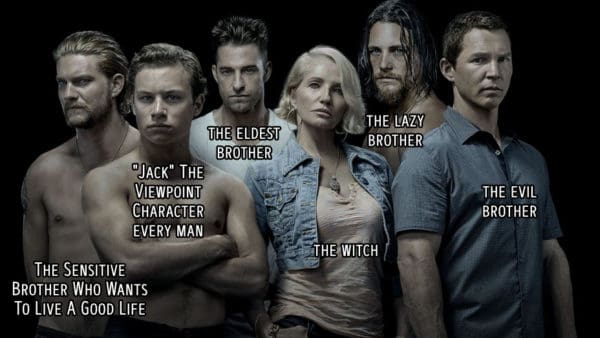Animal Kingdom is an Australian movie based on a Melbourne family who wreaked a lot of havoc in the 1980s. This movie was the inspiration for the American TV spin-off set in San Diego. Below I make the case that Animal Kingdom is a modern fairytale.
Breaking Bad is also a modern fairytale blended with crime and heist plot elements. I believe the Animal Kingdom writers modelled this show on Breaking Bad. But I prefer the female characters in Animal Kingdom. Breaking Bad feels like a story made for and about men. Animal Kingdom includes women. The male actors are oftentimes subjected to the female gaze; a sure sign that women as audience have been considered this time.

ANIMAL KINGDOM: THE TITLE
The word ‘Kingdom’ is very fairytale. Here we have a family who consider themselves head honchos of their local area. The world around them is their kingdom, and the spoils are there for their taking. This harks back to the medieval social structure of aristocrats versus serfs, in which aristocrats had everything and serfs owned nothing. They maintained this hierarchy by switching off empathy for others and bald brutality.
FAIRY TALE CHARACTER ARCHETYPES

Joshua (J)
Joshua is the poor boy with no mother and no father. Our initial viewpoint character loses his mother to potions (drugs). Many children’s stories in particular use this plot device. A character without a mother is a sympathetic character.
In English fairy tales, the sympathetic character is often called ‘Jack’ or ‘John’. Jack and the Beanstalk is one of the most famous. In this story, Joshua is shortened to J. This guy is one of the J crew who often stars in fairy tales.
Smurf
Smurf is the wicked grandmother — the archetypal witch. Smurf uses what looks like magic, but which is really street smarts and wits, in a complex system of crime few would get away with in reality. The audience must suspend disbelief. Like a wicked witch, Smurf can grant great riches but take them away just as easily. Like a fairy tale witch, she often seems to be doing the prince a favour: In a fairy tale the witch turns a prince into a tree, but perhaps to assuage her own guilt, she grants him the body of a dove for two hours per day. Likewise, Smurf does all the kind, motherly things for her sons, but maintains complete control.
Smurf lives in a ‘house made of candy’ in the middle of a suburban forest — an opulent gated mansion which attracts hangers-on from all around.
There’s something eerie about Smurf, as played by Ellen Barkin. She is glamorous in the original, magical sense of the world. In fairytales, as in medieval times, the elderly were treated with great suspicion. Smurf is in transition when it comes to her relationship with her boys; she’s in danger of clicking over from ‘wise and respected’ old person to a nuisance. This comes to the fore in season four. See: Sacrificing One’s Grandmother. This has been foreshadowed with J’s abandonment of the elderly woman with dementia.
Cody is a Gaelic name, but I believe if there’s any symbolism to Janine Cody’s last name, it’s down to American frontiersman and showman Buffalo Bill Cody (1846-1917).
In fairy tales — witches and godmothers excepted — girls and women do not have agency. Men rule the world. While the female characters in this show do have some basic agency — Nicky chooses to move in with J. Ordinary women will never be a part of this world. They need some kind of superpower. Smurf the Witch is of course the exception, conforming to the age old rule that in order to have true agency in a story, a female character must be magical. Smurf could take other women under her wing, but instead sees other women as threats rather than allies. If she takes them in, it’s because she’s keeping her enemies closer.
Ellen Barkin’s character is not entirely fairytale — her character is a more modern take on the witch. Witches in the Grimm era and previously were sexually repulsive, but Smurf uses her sexuality to get what she wants. This power is waning, but only because of her age. Smurf is an intriguing admixture of the sexualised and the grotesque aspects of a witch, who even uses her sexuality to influence her own sons. (This was set up in the pilot, but perhaps it was a bridge too far, because little has been done with this incestuous plot line, yet.)
The Brothers
The three brothers are the archetypal three brothers from a fairytale.
One brother, Pope, has been on a big journey (prison) and returns at the beginning of the tale. Though Pope is the eldest of Smurf’s sons, he doesn’t play the role of eldest son and heir to the throne. He has been usurped by Baz, the orphan rescued from drowning in the river.
The youngest brother, Deren, is gay, which marks him out as not fitting into this macho world. He wants out of the world of magic. He wants to become a woodworker (own a simple pub) and live in the pious world. The problem is, he’s been brought up on crime and has no idea how to live in the law-abiding world, paying taxes and dismissing staff fairly and so on. He can never put aside the fact that he grew up in a house of magic. He doesn’t belong there.
Another brother, Craig, is the lazy one, interested in getting high and parties and sleeping with women. This is his main fault, and it will be his downfall.
A fourth ‘brother’, Baz, is Smurf’s favourite, in a way. This brother is not related by blood. Perhaps this means he’s not imbued by the same magic. He soon loses his life. This conforms to a very primitive and conservative idea which runs throughout storytelling — that blood family is your true family. Any outsiders will be punished eventually.
The new brother (the nephew) eventually becomes the replacement for Baz, the favourite ‘brother’ — favourite because he is more wily than Smurf’s actual sons. J is the ultimate trickster. The complex system of crime Smurf has set up requires a smart person to take over.
Smurf’s own sons have clearly delineated flaws and each their own demons which make it impossible for them to take on Smurf’s role as she retires. Pope is volatile. Craig is lazy. Deren is conflicted and suspicious and not really invested in a life of crime anyway.
For more on fairy tale character archetypes, see this post.
FAIRY TALE PLOT ELEMENTS
After his mother overdoses on heroin, J is taken in by his grandmother. He realises he has landed in a cottage in the forest and that his new, extended family is evil. So this is why his mother worked hard to keep him away from them. He immediately faces a moral dilemma: Do I separate myself from these people or do I learn their way of life? He must choose between light and dark, good and evil. This is a stark moral dilemma reminiscent of the black and white nature of fairy tales.
Sometimes in fairy tales, witches have their powers taken away. This happens to Smurf when she is sent to prison.
Nicky is the naive, pretty (but not dangerously beautiful) peasant girl who doesn’t fully understand the danger of the outside world. Nicky is abducted by Cody enemies partly because of her own naivety. Nicky plays the part of Little Red Riding Hood, warned of the dangers of other people, constantly refusing to listen. Eventually she finds her world so limited that the only safe place for her is within the walls of the Cody Mansion, and even then she’s vulnerable due to her own naivety.
Snow White is basically the same character archetype as Little Red Riding Hood — kind and simple and sweet and vulnerable. Nicky finds herself in a Snow White tale, doing the washing and cleaning for the male ‘dwarfs’ around her, who go out to work each day and allow her to stay there out of their own good graces. There are plenty of fairy tales about young women who find themselves cooking and cleaning for large groups of men in the woods — it just so happens that Snow White is the most famous of the subgenre. In season three, when Mia Trujillo infiltrates the Cody Mansion, Snow White has basically been tricked by another kind of witch. (So has J — even more so.) Or, you could see Mia as a classic trickster character. All wicked witches are also tricksters, despite the powers available to them.
In the “Prey” episode of season three, J and one of his uncles have a problem with a demented tenant. Knowing she’ll soon be questioned by police, J tests her (tests are also common in fairytales) and realises she can’t keep his story straight. So now he has to get rid of her. First the men discuss if they should kill her. No, that is too confronting for them. Instead, the writers borrow from fairy tale logic. They take her far away, dump her at a bus stop, tell her they’re going to bring her a milkshake then drive off, leaving her alone with her beloved cat. This subplot has the story structure of Hansel and Gretel. Gerontricide was a reality in earlier human eras, especially when we were still nomadic.
Animal Kingdom is basically a return to an earlier, more brutal time, and reminds us that our veneer of civility is just that; a veneer. We all have a price.

